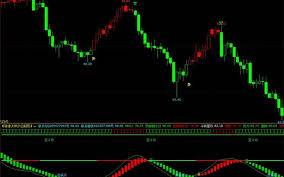Understanding the KDJ 指标 Thinkorswim

The KDJ 指标 Thinkorswim is a powerful technical analysis tool that traders use to evaluate price trends and identify potential turning points in the market. This indicator is an enhanced version of the stochastic oscillator and is widely used for its ability to pinpoint overbought and oversold conditions, as well as detect momentum shifts. By integrating the KDJ indicator into the Thinkorswim platform, traders can gain a deeper understanding of market dynamics and make more informed decisions.
What is the KDJ Indicator?
The KDJ indicator was initially designed in the Chinese stock market and has since gained global popularity. It consists of three primary components: the K line, the D line, and the J line. These components work together to offer valuable insights into market movements, particularly regarding short-term price changes.
- K Line: The K line is the faster of the two main lines in the KDJ indicator. It is calculated based on the difference between the highest high and the lowest low within a set period. The K line responds quickly to changes in price, providing an immediate view of the market’s momentum.
- D Line: The D line is a smoothed version of the K line, essentially averaging the K line over a specified period. This makes the D line slower and more stable, providing a clearer view of the prevailing trend. The D line helps smooth out the noise from short-term fluctuations in price.
- J Line: The J line is derived from the K and D lines, and it is the most volatile of the three. It can often swing well above or below the K and D lines, offering the most sensitive and responsive readings. The J line is particularly useful in identifying overbought or oversold conditions and can signal potential price reversals before they happen.
How Does the KDJ Indicator Work?
The KDJ indicator is designed to detect the momentum and strength of a trend. It combines the stochastic oscillator’s principles with additional smoothing to generate more reliable signals. Here’s how the KDJ indicator works:
- Momentum Indication: The KDJ tracks the momentum of a market by calculating the difference between the highest and lowest points within a specific timeframe. This gives traders an idea of how strong the current trend is and whether the market is becoming overbought or oversold.
- Crossovers Between K and D Lines: One of the key signals provided by the KDJ indicator is the crossover between the K and D lines. When the K line crosses above the D line, it is seen as a bullish signal, suggesting that upward momentum is increasing. On the other hand, when the K line crosses below the D line, it is seen as a bearish signal, indicating that the market may be shifting into a downtrend.
- J Line Extremes: The J line is highly sensitive to changes in price, and when it moves far from the K and D lines, it can indicate extreme market conditions. A J line that rises sharply above both the K and D lines may signal an overbought condition, while a J line that falls significantly below both lines may indicate an oversold condition. These extreme readings can often be followed by price reversals or consolidations.
- Trend Reversals: By monitoring the J line’s behavior, traders can spot potential trend reversals. When the J line shifts direction and crosses back over the K and D lines, it can signal a change in the prevailing trend. This makes the KDJ indicator particularly useful for short-term traders looking to capitalize on market fluctuations.
How to Use the KDJ Indicator on Thinkorswim
Thinkorswim, a popular trading platform by TD Ameritrade, offers traders the ability to customize their charts and technical indicators. To use the KDJ indicator in Thinkorswim, follow these steps:
- Add the KDJ Indicator: Open your Thinkorswim platform and go to the “Charts” section. From there, click on the “Studies” button located at the top of the screen. In the search bar, type “KDJ” and select the appropriate study. The KDJ indicator will then appear on your chart, allowing you to analyze price movements.
- Customize the Parameters: After adding the KDJ indicator to your chart, you can customize the period settings for the K, D, and J lines to match your trading style. Some traders prefer shorter periods for quicker signals, while others use longer periods for a more comprehensive view of market trends. Experimenting with different settings will help you find the optimal configuration for your trading strategy.
- Interpret the Signals: Once the KDJ indicator is applied to your chart, you can begin interpreting its signals. Look for crossovers between the K and D lines as potential buy or sell signals. Pay close attention to the J line’s behavior, especially when it reaches extreme highs or lows, as this may indicate an impending price reversal.
- Combine with Other Indicators: While the KDJ indicator is a valuable tool, it is often more effective when used in conjunction with other indicators. For example, you might combine the KDJ with moving averages, the Relative Strength Index (RSI), or the Average True Range (ATR) to confirm trade signals and improve your overall analysis.
Advantages of the KDJ Indicator
The KDJ indicator offers several advantages to traders, especially those focused on short-term price movements:
- Sensitivity to Price Changes: The J line is highly sensitive to price changes, making it an excellent tool for identifying early signs of trend reversals. This responsiveness can be crucial for traders looking to capitalize on short-term price swings.
- Clear Buy and Sell Signals: The KDJ indicator provides clear and actionable signals, especially through the crossovers of the K and D lines. These signals are easy to interpret, making the KDJ suitable for traders of all experience levels.
- Versatility: The KDJ indicator can be used across various timeframes, from minutes to days or weeks. This flexibility allows traders to adapt the indicator to different trading strategies, whether they are day trading or swing trading.
- Trend Confirmation: The KDJ indicator helps confirm the strength of a trend. By analyzing the relationship between the K and D lines and the J line’s behavior, traders can determine whether a trend is likely to continue or if a reversal is imminent.
Disadvantages of the KDJ Indicator
While the KDJ indicator is a powerful tool, it does have some limitations:
- False Signals: Like all technical indicators, the KDJ indicator can produce false signals, especially in volatile or choppy market conditions. Traders should combine it with other tools and analysis methods to confirm signals and reduce the risk of errors.
- Lagging Nature: The KDJ indicator is based on historical price data, which means it can lag behind the actual market movements. This lag can be particularly problematic in fast-moving markets or during major news events.
Read also: Timtum Halev Firewood: Premium Firewood for a Cozy, Sustainable Experience
Conclusion
The KDJ 指标 Thinkorswim is a versatile and effective technical analysis tool that can help traders identify potential buy and sell signals, as well as gauge market momentum. By combining the KDJ indicator with other technical tools, traders can develop a comprehensive trading strategy that improves their chances of success. As with any trading tool, it is essential to practice proper risk management and always consider the broader market context when making trading decisions.
